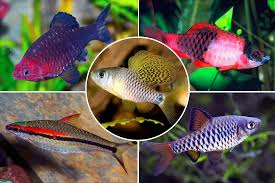
Barb Fish
Conditions of detention
Barbs are relatively easy to care for and can adapt to a variety of water conditions. They do well in tanks with a minimum size of 20 gallons, though larger tanks are preferable for active species like Tiger Barbs. Barbs prefer slightly acidic to neutral water with a pH range of 6.0 to 7.5 and temperatures between 74-80°F (23-27°C). These fish are highly active and enjoy a well-planted aquarium with plenty of swimming space. They are schooling fish and should be kept in groups of at least five to reduce aggression and stress.
Useful Fact: Barbs are schooling fish, and keeping them in groups helps minimize aggressive behavior, especially in more boisterous species like Tiger Barbs.
Nutrition and diet
Barbs are omnivorous and thrive on a varied diet. They can be fed high-quality flake or pellet food, supplemented with live or frozen foods such as bloodworms, brine shrimp, and daphnia. Many species of barbs also enjoy fresh vegetables, such as blanched spinach, zucchini, or peas, which can be added to their diet for extra nutrition.
Useful Fact: A varied diet that includes both protein and plant matter helps maintain the vibrant colors and overall health of barbs.
Health
Barbs are generally hardy fish, but like all aquarium fish, they can be susceptible to common freshwater diseases such as ich, fin rot, and velvet, particularly if water quality is poor. Stress from overcrowding or aggressive tankmates can also lead to health issues. Regular monitoring of water parameters and maintaining a clean environment are essential for preventing disease.
Useful Fact: Regular water changes and maintaining stable water conditions are key to keeping barbs healthy and preventing common diseases.
Grooming and care
Barbs do not require traditional grooming, but their environment needs regular maintenance. This includes weekly water changes of 20-30%, monitoring water parameters, and ensuring the tank is free of uneaten food and debris. Barbs are active swimmers, so a clean, well-maintained tank is crucial to their well-being.
Useful Fact: Barbs are active and energetic, so maintaining a clean and spacious environment is essential for their physical health and mental stimulation.
Education and training
Barbs are not typically trained, but they can learn to recognize their owners and will often come to the surface during feeding times. While not as interactive as some other fish, their schooling behavior and lively swimming make them engaging to watch.
Useful Fact: Barbs thrive in a dynamic environment with plenty of plants and open swimming areas, which helps keep them engaged and active.
Toys and entertainment
Barbs enjoy exploring their environment, so providing them with a well-planted tank that includes rocks, driftwood, and other decorations gives them plenty of places to explore and hide. They are also known for their playful behavior, particularly when kept in groups.
Useful Fact: Barbs are social fish that enjoy interacting with their tankmates, so providing a variety of hiding spots and decorations can reduce stress and encourage natural behavior.
Safety
Barbs can be fin-nippers, especially in smaller tanks or if kept in insufficient numbers. It’s important to provide enough space and keep them in groups to reduce this behavior. They should not be housed with slow-moving or long-finned fish, such as bettas or angelfish, as they may nip at their fins.
Useful Fact: Keeping barbs in larger schools (at least five or more) can help reduce aggressive behaviors, such as fin-nipping.
Accessories
Essential accessories for a barb tank include a reliable filter to maintain water quality, a heater to keep the temperature stable, and a light source that supports plant growth. Barbs appreciate a well-planted tank with plenty of open swimming space and hiding spots created by rocks, driftwood, or caves.
Useful Fact: Barbs are active swimmers that enjoy open spaces, so it’s important to balance plant density with enough room for them to swim freely.
Socialization
Barbs are social fish and do best in groups. They are generally peaceful but can display aggressive behavior, such as fin-nipping, especially if not kept in a large enough school. They do well in community tanks with other fast-moving, similarly sized fish but should be monitored closely in mixed-species tanks.
Useful Fact: When keeping barbs in a community tank, choose tankmates that are fast swimmers and can handle the active nature of barbs.
Travel and Transportation
When transporting barbs, use a plastic bag filled with water from their tank and ensure it is well-oxygenated. Transport them carefully to avoid temperature fluctuations and stress. Keep the bag in a dark, insulated container to minimize stress.
Useful Fact: Barbs are relatively hardy during transport but should be acclimated slowly to their new environment to reduce stress.
Behavior and psychology
Barbs are known for their active and sometimes boisterous behavior. They are social fish that enjoy swimming in schools, and they can be quite playful, especially when kept in large groups. However, some species, like Tiger Barbs, can be fin-nippers, so their tankmates should be chosen carefully. Barbs are generally peaceful but can become aggressive if kept in insufficient numbers or if stressed.
Useful Fact: Barbs are happiest when kept in schools of at least five, which helps reduce stress and encourages natural schooling behavior.
Legal aspects
There are generally no legal restrictions on owning barbs, but it’s important to ensure they are sourced from reputable breeders or suppliers. As with all fish, ethical sourcing helps support sustainable practices and ensures the health of the fish.
Useful Fact: Many barbs available in the aquarium trade are captive-bred, which helps reduce pressure on wild populations and ensures healthier fish for the aquarium.


